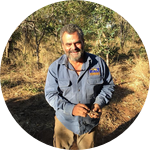About This Project
Highly social with individuals that care for sick, injured, and elderly pack members, African painted dogs are endangered. Populations decreased from half a million individuals to approximately 6000 due to human-related activities such as snares and habitat loss. We aim to understand the scale of a new threat, den disturbance by humans, and evaluate its effects on painted dog behavior and growth rates through zoo collaborations, den camera monitoring, and photograph analysis.
Ask the Scientists
Join The DiscussionWhat is the context of this research?
Multiple factors such as habitat loss, persecution, and other forms of human disturbance played a key role in the population decrease of endangered African painted dogs (Lycaon pictus). Once estimated to total half a million individuals, there are now approximately 6,000. Human disturbance has been shown to affect wildlife by altering foraging behaviors and immune responses, and although observing wildlife can be beneficial for research and education, it may be detrimental if humans are interfering with natural animal behaviors. We are trying to understand both the level at which human presence and/or activity begins to negatively impact the survival of painted dogs, and the extent of the impact.
What is the significance of this project?
Preliminary data indicate the following negative impacts that human presence has on painted dogs: reduced feeding leading to reduced growth rates in pups that compromise survival, more pup-guarders at dens reducing the hunting success of the pack, increased pup mortality by lions and den moves that are precipitated by human presence, and altered behaviors such as hunting at night instead of sleeping.
All of these actions can lead to decreased survival and adversely impact population stability. Results of this study will assist with understanding how human behavior and presence can influence the behavior and survival of painted dogs, and will allow us to improve zoological care and enhance conservation programs.
What are the goals of the project?
This two-phased project will begin immediately and continue through 2017, and possibly 2018, to collect as much data as possible. Phase 1 will capture data on wild painted dog populations through remote download-capable den cameras and photographs. Phase 2 will obtain painted dog feeding and growth rate information from zoological facilities via surveys distributed in collaboration with the African Painted Dog Species Survival Plan. Photographic data will be collected from research teams, painted dog caretakers and visitors at zoological facilities, and public sources (i.e., painted dog groups, travel websites, etc.) and will be stored and analyzed to obtain morphometric scaling (height. length, etc.) for growth rate comparisons between wild and zoological painted dog populations.
Budget
FileMaker Pro: This well supported and flexible program for Macs and PCs will be used to create a database containing information about feeding protocols and growth rates of both wild and zoological painted dogs for comparison purposes, as well as photographs that will be analyzed. The database will be maintained, shared, and expanded as needed.
Game cameras: To lessen researcher presence, remote-download capable cameras will be placed at den sites. Data collected will include litter size, pup activity, pack size, level of human disturbance, predator presence, etc. that can be utilized for both this project and future research.
Housing for game cameras: Hyenas and other species sometimes attempt to remove or damage cameras. This housing will minimize or prevent camera damage.
Endorsed by
Meet the Team
Dr. Greg Rasmussen
Dr. Gregory Rasmussen has been working exclusively with the highly endangered painted dog since 1989. He established the Painted Dog Conservation project in 2002, and more recently, founded the Painted Dog Research Trust (PDRT) in Zimbabwe.
PDRT's mission is to conserve painted dogs using data and research as the guiding tool. In addition, PDRT is constructing a field based conservation ecology center that will encourage ecological and socioeconomic studies. This will allow for the mentoring of Zimbabwean graduate students and the collaboration of international students and researchers to inspire and train the next generation of motivated, field competent, and passionate conservation biologists.
http://www.painteddogresearch.org
Additional Information
Cover photo by Nigel Nicholls 2015
Project Backers
- 37Backers
- 101%Funded
- $2,545Total Donations
- $68.78Average Donation


